- Clone
- 6C1 (See other available formats)
- Regulatory Status
- RUO
- Other Names
- PIRA1, PIR-B Leukocyte immunoglobulin-like receptor 3, LIR-3
- Isotype
- Rat IgG1, κ
- Ave. Rating
- Submit a Review
- Product Citations
- publications
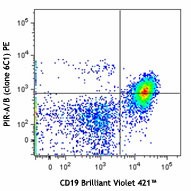
-

C57BL/6 mouse splenocytes were stained with CD19 Brilliant Violet 421™ and PIR-A/B (clone 6C1) PE (top) or rat IgG1, κ PE isotype control (bottom). -

| Cat # | Size | Price | Quantity Check Availability | Save | ||
|---|---|---|---|---|---|---|
| 144103 | 25 µg | $117 | ||||
| 144104 | 100 µg | $252 | ||||
Paired-immunoglobulin-like receptor (PIR) is a type I transmembrane protein, containing six Ig-like domains. Two isoforms (PIR-A and PIR-B) have been reported for this molecule. PIR-A/B is expressed on B cells, mast cells, macrophages, granulocytes, eosinophils, and dendritic cells. PIR-A requires association with FcRγc for its cell surface expression and to act as an activating receptor. The ligand for PIR-A is MHC class I. PIR-B is an inhibitory receptor with 3 ITIM motifs on its cytoplasmic tail; when phosphorylated, they recruit the tyrosine phosphatases PTPN6/SHP-1 and PTPN11/SHP-2. MHC class I, Nogo, MAG, and OMgp are the ligands for PIR-B.
Product DetailsProduct Details
- Verified Reactivity
- Mouse
- Antibody Type
- Monoclonal
- Host Species
- Rat
- Immunogen
- Recombinant extracellular domains 1 and 2 of PIR-A
- Formulation
- Phosphate-buffered solution, pH 7.2, containing 0.09% sodium azide.
- Preparation
- The antibody was purified by affinity chromatography and conjugated with PE under optimal conditions.
- Concentration
- 0.2 mg/ml
- Storage & Handling
- The antibody solution should be stored undiluted between 2°C and 8°C, and protected from prolonged exposure to light. Do not freeze.
- Application
-
FC - Quality tested
- Recommended Usage
-
Each lot of this antibody is quality control tested by immunofluorescent staining with flow cytometric analysis. For flow cytometric staining, the suggested use of this reagent is ≤0.125 µg per million cells in 100 µl volume. It is recommended that the reagent be titrated for optimal performance for each application.
- Excitation Laser
-
Blue Laser (488 nm)
Green Laser (532 nm)/Yellow-Green Laser (561 nm)
- Application Notes
-
Additional reported applications for the relevant formats include: Western Blotting1 and immunohistochemical staining of frozen tissue sections3.
-
Application References
(PubMed link indicates BioLegend citation) -
- Kubagawa H, et al. 1999. J. Exp. Med. 189:309. (WB)
- Nakamura A, et al. 2004. Nat. Immunol. 5:623. (FC)
- Masuda K, et al. 2005. EMBO J. 24:4052. (IHC)
- Product Citations
-
- RRID
-
AB_11203371 (BioLegend Cat. No. 144103)
AB_11204242 (BioLegend Cat. No. 144104)
Antigen Details
- Structure
- Transmembrane proteins, six Ig-like domains. PIR-A associates with FcRγc, doesn't have functional motifs on its cytoplasmic domain. PIR-B contains 3 ITIM motifs on its cytoplasmic domain.
- Distribution
-
B cells, macrophages, dendritic cells, mast cells, eosinophils.
- Interaction
-
PIR-A: FcRγc
PIR-B: Lyn, PTPN6/SHP-1, PTPN11/SHP-2 - Ligand/Receptor
- MHC class I, Nogo, MAG, OMgp.
- Cell Type
- B cells, Dendritic cells, Eosinophils, Macrophages, Mast cells, Neutrophils
- Biology Area
- Cell Biology, Immunology, Signal Transduction
- Molecular Family
- MHC Antigens, Protein Kinases/Phosphatase
- Antigen References
-
1. Matsushita H, et al. 2011. J. Biol. Chem. 286:25739.
2. Arita K, et al. 2011. J. Immunol. 186:7050.
3. Takai T, et al. 2011. J. Biomed. Biotechnol. 2011:275302.
4. Nakamura A, et al. 2004. Nat. Immunol. 5:623. - Gene ID
- 18722 View all products for this Gene ID 18733 View all products for this Gene ID
- UniProt
- View information about PIR-A/B on UniProt.org
Related Pages & Pathways
Pages
Related FAQs
- What type of PE do you use in your conjugates?
- We use R-PE in our conjugates.
Other Formats
View All PIR-A/B Reagents Request Custom Conjugation| Description | Clone | Applications |
|---|---|---|
| Purified anti-mouse PIR-A/B | 6C1 | FC,IHC-F,WB |
| PE anti-mouse PIR-A/B | 6C1 | FC |
| TotalSeq™-A0882 anti-mouse PIR-A/B | 6C1 | PG |
Customers Also Purchased
Compare Data Across All Formats
This data display is provided for general comparisons between formats.
Your actual data may vary due to variations in samples, target cells, instruments and their settings, staining conditions, and other factors.
If you need assistance with selecting the best format contact our expert technical support team.
-
Purified anti-mouse PIR-A/B

C57BL/6 mouse splenocytes were stained with purified PIR-A/B... -
PE anti-mouse PIR-A/B

C57BL/6 mouse splenocytes were stained with CD19 Brilliant V... 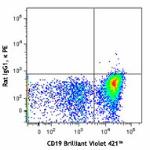
-
TotalSeq™-A0882 anti-mouse PIR-A/B
 Login/Register
Login/Register 









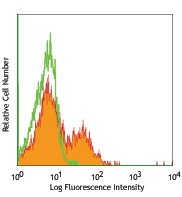

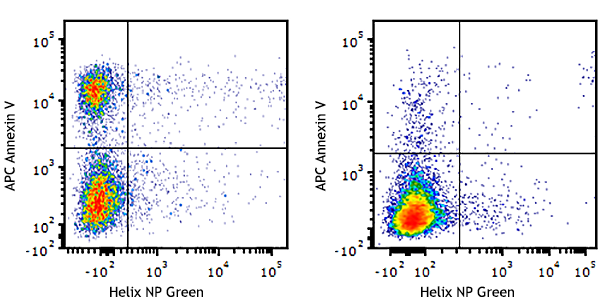
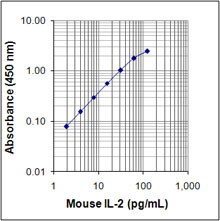



Follow Us